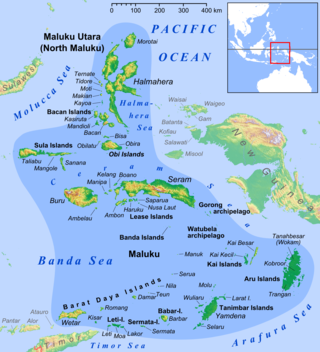
The Maluku Islands or the Moluccas are an archipelago in the east of Indonesia. Tectonically they are located on the Halmahera Plate within the Molucca Sea Collision Zone. Geographically they are located east of Sulawesi, west of New Guinea, and north and east of Timor. Lying within Wallacea, the Maluku Islands have been considered as a geographical and cultural intersection of Asia and Oceania.

Seram is the largest and main island of Maluku province of Indonesia, despite Ambon Island's historical importance. It is located just north of the smaller Ambon Island and a few other adjacent islands, such as Saparua, Haruku, Nusa Laut and the Banda Islands.

Ambon is the capital and largest city of the Indonesian province of Maluku. This city is also known as Ambon Manise, which means "beautiful" or "pretty" Ambon. It covers a land area of 298.61 km2, and had a population of 331,254 at the 2010 Census and 347,288 at the 2020 Census. The city is divided into five administrative districts – namely Nusaniwe, Sirimau, Teluk Ambon, Baguala and Leitimur Selatan. Known as Indonesia's music city, Ambon became the first city in Southeast Asia to be recognised as the UNESCO City of Music in 2019.
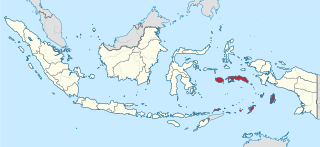
Maluku is a province of Indonesia. It comprises the central and southern regions of the Maluku Islands. The main city and capital of Maluku province is Ambon on the small Ambon Island. The land area is 46,150.92 km2, and the total population of this province at the 2010 census was 1,533,506 people, rising to 1,848,923 at the 2020 census. The official estimate as at mid 2022 was 1,881,727. Maluku is located in Eastern Indonesia. It is directly adjacent to North Maluku, Southwest Papua, and West Papua in the north, Central Sulawesi, and Southeast Sulawesi in the west, Banda Sea, East Timor and East Nusa Tenggara in the south and Arafura Sea, Central Papua and South Papua in the east.
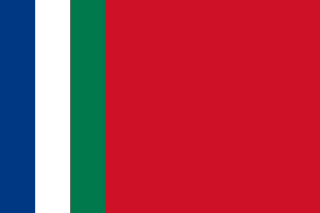
South Maluku, also South Moluccas, officially the Republic of South Maluku, was an unrecognised secessionist republic that claimed the islands of Ambon, Buru, and Seram, which make up the Indonesian province of Maluku.

De Punt is a village in the Dutch province of Drenthe. It is a part of the municipality of Tynaarlo, and lies about 11 km south of Groningen. The village closely cooperates with Yde and they are often referred to as Yde-De Punt, however both are still separate villages.

The Ambonese, also known as Moluccans, are an Indonesian ethnic group of mixed Austronesian and Melanesian origin. They are majority Christians followed by Muslims. The Ambonese are from Ambon Island in Maluku, an island group east of Sulawesi and north of Timor in Indonesia. They also live on the southwest of Seram Island; which is part of the Moluccas, Java, New Guinea; on the West Papua side and other regions of Indonesia. Additionally, there are about 35,000 Ambonese people living in the Netherlands. By the end of the 20th century, there were 258,331 Ambonese people living in Ambon, Maluku.
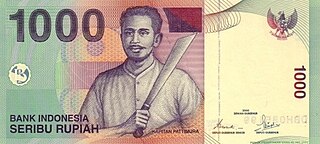
Thomas Matulessy, also known as Kapitan Pattimura or simply Pattimura, was a famous Ambonese soldier who became a symbol of both the Maluku and Indonesian struggle for independence, praised by President Sukarno and declared a national hero by President Suharto. He has several namesakes in both the Netherlands and in the Indonesian archipelago.

Johan Teterissa was a Moluccan elementary school teacher, activist and member of the Republic of the South Moluccas, or RMS, an active separatist group which advocates independence for the Maluku islands from Indonesia. Teterissa was sentenced to life in prison for treason in April 2008 after leading a nonviolent protest against Indonesian rule in 2007. Teterissa, and a group of 19 traditional Moluccan dancers, unfurled a secessionist flag of the banned South Moluccan Republic in front of Indonesian President Susilo Bambang Yudhoyono on June 29, 2007, in Ambon, the capital of Maluku. Amnesty International designated him a prisoner of conscience.
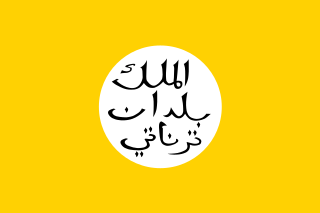
The Sultanate of Ternate, previously also known as the Kingdom of Gapi is one of the oldest Muslim kingdoms in Indonesia besides Tidore, Jailolo, and Bacan. The Ternate kingdom was established by Momole Cico, the first leader of Ternate, with the title Baab Mashur Malamo, traditionally in 1257. It reached its Golden Age during the reign of Sultan Baabullah (1570–1583) and encompassed most of the eastern part of Indonesia and a part of southern Philippines. Ternate was a major producer of cloves and a regional power from the 15th to 17th centuries.

Moluccans are the Austronesian-speaking and Papuan-speaking ethnic groups indigenous to the Maluku Islands, Indonesia. The region was historically known as the Spice Islands, and today consists of two Indonesian provinces of Maluku and North Maluku. As such, "Moluccans" is used as a blanket term for the various ethnic and linguistic groups native to the islands.

Indonesia and the Netherlands established diplomatic relations in 1949. Both countries share a special relationship, embedded in their shared history of colonial interactions for centuries. It began during the spice trade as the Netherlands established the Dutch East Indies Company (VOC) trading post in what is now Indonesia, before colonising it as the Dutch East Indies until the mid 20th century. Indonesia was the largest former Dutch colony. In the early 21st century, the Dutch government has committed to boosting its relationship with Indonesia, noting that economic, political, and interpersonal contacts should be further strengthened.
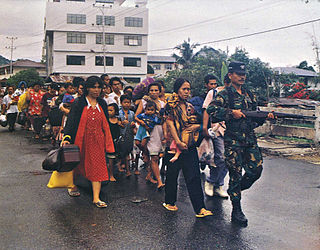
The Maluku Islands sectarian conflict was a period of ethno-political conflict along religious lines, which spanned the Indonesian islands that compose the Maluku archipelago, with particularly serious disturbances in Ambon and Halmahera islands. The duration of the conflict is generally dated from the start of the Reformasi era in early 1999 to the signing of the Malino II Accord on 13 February 2002.

Martha Christina Tiahahu was a Moluccan freedom fighter and National Heroine of Indonesia.
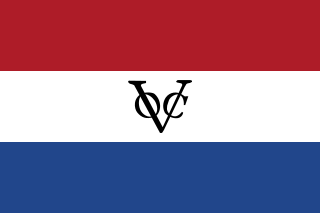
Ambon was a governorate of the Dutch East India Company, consisting of Ambon Island and ten neighbouring islands. Steven van der Hagen captured Fort Victoria on 22 February 1605 from the Portuguese in the name of the Dutch East India Company. Until 1619, Ambon served as the capital of the Dutch possessions in East Asia. In that year Batavia was founded to function as the staple port for the Dutch East India Company in Asia. The island was the world center of clove production until the 19th century. The Dutch prohibited the rearing of the clove-tree in all the other islands subject to their rule, in order to secure the monopoly to Ambon.
The Moluccan diaspora refers to overseas Indonesians of Moluccan birth or descent living outside Indonesia. The most significant Moluccan diaspora community lives in the Netherlands, where it numbers c. 70,000 people as of 2018.
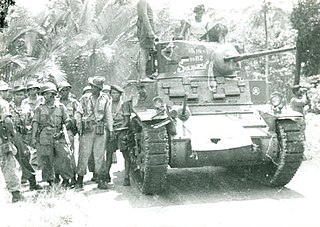
The Invasion of Ambon was a combined Indonesian military operation which aimed to seize and annex the self proclaimed Republic of South Maluku.

Johannes Latuharhary was an Indonesian politician and nationalist of Moluccan descent, who served as the first Indonesian governor of Maluku from 1945 until 1955, though he did not assume office in Maluku until 1950. A Protestant Christian, Latuharhary was an early proponent of Moluccan inclusion in the Indonesian state and he was an active participant in the struggle for Indonesia's independence.

On 26 September 2019, a strong magnitude 6.5 earthquake struck Seram Island in Maluku, Indonesia, near the provincial capital of Ambon. The earthquake struck at 07:46:44 Eastern Indonesia Time with a shallow depth of 18 km. The tremor could be felt throughout the island, with an intensity of very strong (VII) reportedly felt in the provincial capital of Ambon.

Johanis Hermanus Manuhutu was a South Moluccan civil servant in the Dutch East Indies and the first president of the Republic of South Maluku in 1950.





















